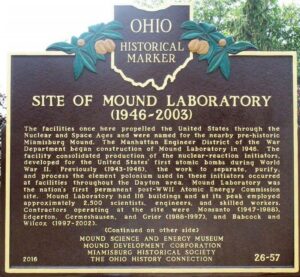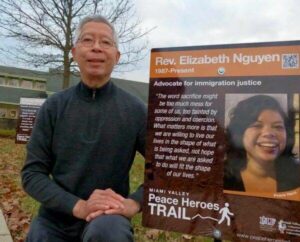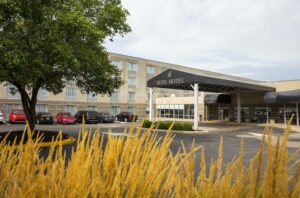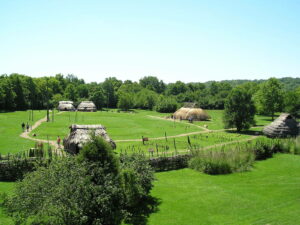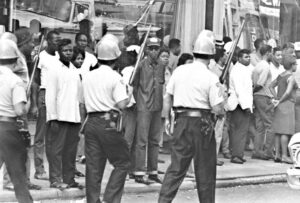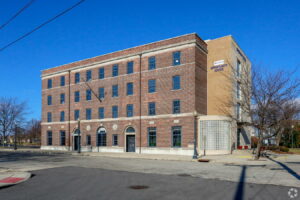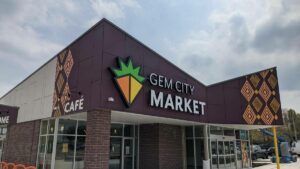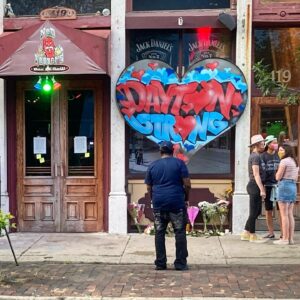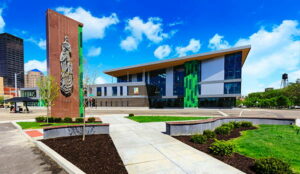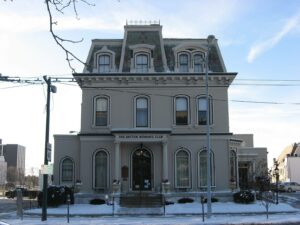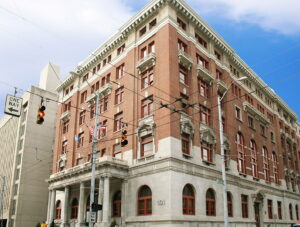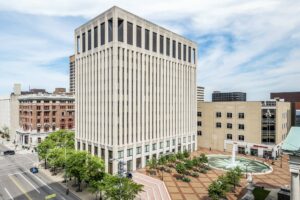The Dayton Peace Trail
Around the United States there are many monuments and historical markers memorializing places of violence and conflict, yet very few marking spaces and places of peace work, conflict mediation, and justice activism.
This trail is designed to help us remember and pay tribute to those spaces of peace and justice in our community. This is not an exhaustive list nor does it represent all the diverse ways our community has come together to make peace. We hope you will make time to visit these spaces of peace-building and explore the significance of the sites on this trail. As you visit each site, we encourage you to take time and read through the history of each location and think of ways you can continue to support spaces of peace and justice building. This trail was made possible in part by Ohio Humanities. The International Peace Museum would like to thank Kathleen Gish, Faheem Curtis-Khidir, Andrew Walsh, and Katherine Rowell for their efforts in helping to develop this trail.
The Dayton Peace Trail
“The term ‘peacebuilding’ refers to activities that root out causes of violence as well as instill broad measures to prevent violent conflict and create sustainable peace”
-Tammy Newsome, A History of Peace in Dayton, Ohio
Click on each location name for more information!
|
The Miamisburg Mound Protest Site900 Mound Round MiamisburgClick Here for hours and directions. This site serves to both honor those cultures who served as earlier stewards of this land, as well as those who are still taking bold action to call attention to the many atrocities still being visited upon indigenous peoples. “Miamisburg Mound is one of the two largest conical mounds in eastern North America. Listed on the National Register of Historic Places, the mound is 65 feet tall and 800 feet in circumference and contains 54,000 cubic yards of earth. The mound is visible from several miles away because it stands atop a 100-foot high ridge above the Great Miami River… Monuments like Miamisburg Mound served as cemeteries for several generations of ancient Ohioans. They also may have marked the boundaries of tribal territories. There were once an estimated 10,000 American Indian mounds and earthworks in the central Ohio Valley. Today, about 1,000 of those landmarks have survived through private landowners and local, state and federal agencies dedicated to preserving these ancient ruins. Many of the mounds that have been saved were of the conical variety and most of those have never been professionally investigated to determine their contents or age. Those that have been investigated were determined to be burial mounds and to have been created between 2,000 and 2,800 years ago. In much of Ohio and neighboring states, the Adena culture transformed into the Hopewell culture at around A.D. 400. These cultures were the ancestors of the American Indian tribes living in the region during the early historic era” (Ohio History Center 2021). The Miamisburg Mound was also among many sites that were chosen as symbolic sites on the Long Walk for Survival in 1980. This demonstration is just one of many instances in which Native American activists are still fighting for justice for people and the land. “The Long Walk for Survival was a 3,500-mile trek across the United States that began on June 1, 1980 and was led by Native American representatives of over 80 different tribes. Over a five-month period, approximately 430 people marched from California to Washington D.C. to demand an end to nuclear development, the forced sterilization of indigenous women, the military draft, and uranium mining on native land. At the time, about 55% of U.S. uranium mines were located on Indian reservations, exposing local communities to radioactive waste that causes cancer and birth defects. It was also discovered that about 40 to 50 percent of Native American women had been sterilized without their consent. This mass sterilization, coupled with the toxic conditions of the reservations, was compromising the native people’s autonomy and contributed to their genocide. The Long Walk for Survival demanded an end to the violence and war inflicted on both the native people and the Earth and sought to create a shift towards stronger spirituality and respect.” (S.F. Indian Center “Watha” Graphics 1980) |
The Miami Valley Peace Heroes Trail8690 Yankee St, DaytonClick here for information about visiting. This site honors local, national, and international peace workers and justice advocates. Located on the grounds of the Miami Valley Unitarian Universalist Fellowship, this project recognizes a vast swath of individuals, organizations, and groups that have worked to advance human rights. Local Peace Heros include Sister Dorothy Stang, Mama Nozipo Glenn, Chris and Ralph Dull, David and Doris Ponitz, and Amaha Selassie. (Not all Peace Heroes appear on the trail. For more information about Peace Heroes see: www.21cplf.org/peace-heroes-gallery) “Celebrating its status as the first Peace Heroes Trail in the nation, our fundraising event summer 2020 raised funds to help support local peace literacy work right here in the Miami Valley. More specifically, the local 2020 designee of the funds is the Miami Valley Unitarian Universalist Fellowship. 100% of the funds after event expenses are designated for the peace literacy work conducted by MVUUF in collaboration with many community partners… The project features attractive trail marker signs on the MVUUF campus plus a Virtual Peace Heroes Trail that can be accessed while touring the site. Fundraising teams selected Peace Heroes to honor and provided summary info that is placed on the markers. Each team has its own page online that also provides information and a video or photo that helps the public-at-large get better acquainted with their Peace Hero.” (Miami Valley Unitarian Universalist Fellowship 2019) |
Dayton Peace Accords Site10823 Chidlaw Road, DaytonClick here for hours and directions. This site honors the vital work that goes into peacebuilding. The Dayton Peace Accords, which ended the brutal Bosnian war. The Peace Conference was held in November of 1995 at the Hope Hotel on Wright Patterson Air Force base. “During the late 1980s and early 1990s, numerous communist countries experienced upheavals. The United States had emerged from the Cold War victorious, and people who had lived under communism for decades rose up and overthrew their communist governments. Struggles ensued, sometimes violent ones, as different factions tried to gain control of the new governments. This was the case for Yugoslavia. In 1991, the communist government in this country collapsed. Various ethnic factions warred against each other to gain political power over their respective enemies. Yugoslavia quickly dissolved into several new political regions, including Serbia, Bosnia and Herzegovina, and Croatia. For four years, bloodshed occurred in these areas, as various groups tried to gain control. Approximately 250,000 people, many of them innocent civilians, died in the fighting, and another two million people fled for their lives. Soldiers from the North Atlantic Treaty Organization entered the former Yugoslavia and struggled to establish peace. In October 1995, the presidents of Serbia, Bosnia, and Herzegovina, and Croatia agreed to come to Dayton, Ohio, to discuss ending the violence. The talks, known as the Dayton Peace Talks, occurred at Wright-Patterson Air Force Base. The parties made an agreement known as the Dayton Peace Accords, which created two new sovereign states, Bosnia and Herzegovina. Hoping to eliminate further ethnic conflicts, Muslim Croats would control one country, while Bosnian Serbs would rule over the other. The Dayton Peace Accords established relative peace in the region, although some ethnic conflicts continued to occur, especially in Kosovo. In 2000, the president of Serbia, Slobodan Milosevic, was removed from office. Since his removal, violence has declined in the region. NATO forces remain in the area, trying to maintain peace.” (Ohio History Center 2021). “A bench and plaque commemorate the Peace Walk, a winding sidewalk between the Hope Hotel, which served as the site of the official negotiations leading to the Dayton Peace Accords, and visiting officer quarters on Wright-Patterson Air Force Base, where the diplomats stayed. The unofficial talks that happened as the diplomats walked back and forth are credited with playing a role in the successful end of the Bosnian War” (Rollins 2020). |
|
SunWatch Indian Village Site2301 West River Road, DaytonClick here for hours and directions. This site honors the original inhabitants that occupied the land we now know as Dayton while recognizing that colonialism attempted to erase those peoples and cultures. SunWatch is emblematic of a victory over oppression, and an appreciation of the importance of indigenous culture. Indigenous societies cultivated a reciprocal relationship with the land and environment. In learning about these various and varied societies, we may just be able to envision a world different from the one in which we now live, one in which we view our responsibility to the earth as paramount. We acknowledge that we occupy lands that were stolen from indigenous populations through coercion and violence. Dayton and surrounding areas sit upon the ancestral and contemporary lands of the Shawnee, Leni Lenape (Delaware), Ottawa, Miami, Wyandot, and Seneca-Cayuga peoples. (For an interactive map of indigenous lands, visit: https://native-land.ca/.) As a result of the 1795 Treaty of Greeneville and the Indian Removal Act of 1830, Native peoples were forcibly displaced. “The Mission of SunWatch Indian Village/Archaeological Park is to protect, preserve and research the cultural remains of the SunWatch National Historic Landmark archaeological site and to serve as a visitor and educational center for archaeology, Native American culture, and heritage stewardship as they relate to the site” (Dayton Society of Natural History 2021). “Sunwatch is a reconstructed village from the Fort Ancient Culture, who were moundbuilders and are associated with the Fort Ancient site in Lebanon, Ohio and are also thought to have built the Serpent Mound…The Fort Ancients were gone by the time Europeans arrived in the Ohio region, replaced by the Shawnee, as they shared a geographic distribution and made their tools in a similar fashion, and could just be what the Fort Ancient Culture became as time moved on.” (McIntire 2012) |
Site of NCR Building 26Corner of Stewart and Patterson St.During WWII, the British developed a machine called a Bombe that was able to decode secret German messages written using their cryptic Enigma machine. The Germans, however, added a fourth rotor to the device in 1942, making it no longer possible to decipher the messages. Daytonian, Joseph Desch headed a top-secret program in 1942 and 1943 at National Cash Register to develop an American version of the code-breaking Bombe that could break improved German machines. Hundreds of Navy WAVES (Women Accepted for Volunteer Emergency Service) worked in Dayton during World War II building top-secret machines. None were sure exactly what they were helping to build, but it clearly saved lives and help to end the war in Europe. The film, “The Imitation Game,” was made about British Bombe engineer, Alan Turing and his work but failed to recognize the work of Joe Desh and NCR in Dayton, when the British machine no longer worked. In 1947, President Harry Truman, however, awarded Desch the Medal for Merit, the highest U.S. civilian decoration, for his wartime work. Desh, and Building 26 are gone, but their contributions to ending war are remembered and appreciated. |
West Dayton Uprising Site1020 West Fifth St, DaytonThis site recognizes the history of segregation in Dayton, and the event that served to catalyze long-standing tensions smoldering within the Black residents of the West Side, in response to their subjugation at the hands of both the social institutions—government, police, education, etc.—as well as the violence visited upon the Black community by individuals. At 1020 West Fifth Street, Lester Mitchell was shot by a white assailant on September 1, 1966 (Baker and Nalls 2016). According to Sweigart (2016): “The drive-by shooting of a black man in front of his home kicked off one of the city’s worst race riots on Sept. 1, 1966. The killing was the final spark for West Dayton, which was seething with frustration over issues related to race and segregation…In a city where housing segregation crammed 60,000 black residents into what many perceived as a ghetto with neglected schools and discriminatory city services, the senseless killing was more than a spark. It was a volcanic eruption.” Former Dayton Police Lieutenant Dan Baker wrote Blood in the Streets: Racism, Riots and Murders in the Heartland of America exploring the racism, violence, and desegregation in Dayton, which provides a rich context for the uprising of 1966, as well as subsequent instances of civil unrest. In an article from the Dayton Daily News, he states: “I was a new rookie cop working the West Side in 1966 when a Black man was murdered in 1100 block of West Fifth Street on a hot night by a drive-by shotgun shooter. The city’s first and worst riot began and required 1,000 Ohio National Guard Soldiers to quell the violence. My wife, Gwen Nalls, who is Black, was a teenager on the West Side during the riots. Against the backdrop of one of America’s most violent decades, 1965-1975, West Dayton suffered four riots. In the same decade, a white racist shot more than 30 Black men over four hot summers. He always used a shotgun firing from his car and hated the desegregation of Dayton Public Schools. He ultimately murdered Dr. Charles Glatt, a federal court appointee who had just arrived to oversee the desegregation plan.” (Baker, and Nalls 2021) Over forty years later, Dayton, Ohio remains one of the most segregated cities in the nation, with 2017 statistics showing that “62.8 percent of the population lives predominantly in neighborhoods of their own races” (Gurnig 2017). Though often dismissed as simply an organic outcome of individual decision making, contemporary residential patterns are inextricably tied to both historic and present-day policies. Lending intuitions, government agencies, educational structures, and economic forces have actively maintained segregation, and the resultant disparities in opportunity and access to resources. Many are only now coming to understand the ways that today’s de facto segregation is related to the redlining policies that created the de jure segregation throughout the early part of the 20th century, solidifying patterns that continue to impact our communities—particularly our communities of color—today. (For more information about the legacy of redlining in Dayton, Ohio, please view the videos created by the Dayton Metro Library exploring the Undesign the Redline exhibit, 2021: https://www.youtube.com/playlist?list=PLGbMtl-QMR04s-V4U5gKVi3bR7k5YTyjp) |
|
Fifth Street YMCA907 West Fifth Street, DaytonThis site honors the value of self-determination within communities that have been the targets of both symbolic and literal violence. Black Daytonians marshaled the human capital within the community and created an autonomous space in which they could. “The ‘colored’ YMCA was founded in 1889. The black YMCAs in the United States was active and growing greatly. In Dayton, this was also true. In 1910 most black YMCA groups did not own property of their own. With the help of men like E.T. Banks helped make Fifth Street Y the oldest incorporated ‘colored’ Y in the country, even without a dedicated space of their own. The Fifth Street YMCA started Boy Scout Troop 30 in 1919 under A.W. Payne. The mission to help boys become men would be a fundamental part of the Fifth Street YMCA branch, inscribing the words ‘Boys’ and ‘Men’ above the two entrances to the building to come. As these Young members grew in Mind, Body, and Spirit they would eventually be allowed to enter through the ‘Men’ door. With fundraising efforts coinciding with the building of the Central YMCA, the Fifth Street YMCA branch was built on the west side of Dayton (907 West Fifth Street) and opened to the public on New Year’s Day, 1928 as the 18th privately owned black YMCA building in the nation. It was four stories high with a gymnasium, swimming pool, cafeteria, recreation rooms, and a residence for fifty men. Inscribed in the exterior of the building were the names of four renowned black men: Booker T. Washington, Frederick Douglass, William A. Hunton, and Paul Lawrence Dunbar. The Dayton YMCA Fifth Street branch was the nation’s longest-lasting black YMCA.” (YMCA of Dayton Ohio 2021) In 2020, the National Parks Service awarded Early Visions—a Dayton non-profit—$500,000 towards preserving this building. “The Early Visions Purpose Center will serve to expose women’s history while providing responsive programs dedicated to the skills of community resident girls and young women. The historical roles, contributions, and legacy of West Dayton’s African American women will be highlighted. This is the perfect In an interview on National Public Radio, President and CEO, Ms. Elizabeth Early-Gainous explains the significance of this site to the local community: “Number one it’s the first Black YWCA in the United States, and you’re standing here at the steps of the mother of integration. This property and the YWCA Central and the Black YWCA integrated in the 1950s during the time that women did not have credit, and women’s surnames were their husband’s name. These Black educated women pooled together their funds and bought this Kuntz mansion back in 1941. When I was a little girl, I would sit up on the old Dunbar and MacFarlane school grounds and watch the ladies come in this building with their pillbox purses and hats and gloves, carrying their beautiful dishes with cakes. I wanted to be those women. I used to sneak over here and peep in. When that door opened up one day, I had the opportunity to go in. A young lady was having a discussion with another young lady, I don’t know what it was about. What she told her was, ‘You are enough.’ And she peeped around the corner and she said, ‘And you’re enough too.’ From that day, I became a lifetime member of the West Side YWCA. They did field trips. You could do art. I learned just about everything that I am today from the women of yesterday. My grandmother was a music teacher here, Ms. Rachel Early-Powell. When she would come and do music, I would sit and I would look and say, ‘Wow, these are women of my community, not the people on TV, not the people that you’ll never see. These are people that are in my community making my community strong.’ Like I said, where we’re standing right now is the mother of integration. It was a beautiful thing, in some ways. It’s a double-edged sword. When we integrated the girls were no longer using the dormitories here. The girls were going downtown or going to other organizations. So, when we integrated, it closed and it left a hole in our community. I’m here to fill that hole again. We’re here to fill that hole. For the last 22 years, I’ve been supporting this property and trying to keep this property for my community. It’s been very, very difficult. I’ve had a lot of break-ins. It has gone through a lot and it’s been very difficult financially. When I found out I got that grant, I exhaled. I’ve been holding my breath for so long. Getting a civil rights grant in West Dayton in 2020, the year of women is a blessing. This building here will be a refuge, where you can come in and be who you are. I want to do a music studio. I want to teach economics, it’s so important. Self-pride, self-esteem, self-confidence, self-worth. I walked into this building as a little girl and I came out as a woman. A woman with pride in their community and the color of my skin. I was proud to be a strong Black woman and I got that here. That’s what I want the other girls in my community to do.” (Goldstein 2020). |
Salem Avenue Peace CorridorSalem Avenue from Hillcrest to Avenue to the Great Miami River, starting with the Richard C. Holbrooke Memorial Bridge and Plaza over the Great Miami River, DaytonThis site recognizes the power of vision, and how it can be used to create change. The Salem Avenue Peace Corridor is an effort to reframe and revitalize an area that has seen significant disinvestment, underpinned by racism codified by disproportional economic development. The mission of the Salem Avenue Peace Corridor is “to establish Salem Avenue and adjacent neighborhoods as a Community of Peace –with Safety, Prosperity, and Quality of Life.” (Salem Avenue Peace Corridor 2021.) “For nearly two centuries, Salem Avenue has served as a major gateway connecting people in the northwest regions of the Dayton area to the City of Dayton, Downtown Dayton, and beyond. For much of the twentieth century, the areas along Salem Avenue were home to many of the wealthy residents of the Miami Valley. Beautiful neighborhoods were filled with grand homes and graceful, tree-lined streets, and this was THE place to live. Over the past thirty years, however, changes occurred in demographic, economic, and social conditions along the corridor. These changes, which occurred throughout the Miami Valley, contributed to the loss of businesses and residents along the corridor. Following national trends, many wealthy families invested in and moved to the outlying Dayton suburbs. At the same time, the population in the northwest neighborhoods of the City became more diverse. As people migrated to the suburbs, disinvestment occurred along the Corridor, and vacant houses and businesses appeared. The once-dynamic commercial corridor between Riverview Avenue and North Avenue no longer provides goods and services to satisfy local demand. Conversely, a lower population, and competition from shopping malls in outlying communities, reduced the support for businesses along the corridor. Housing prices in area neighborhoods declined as vacancy rates grew. Some of the housing stock deteriorated. Consumer preferences for housing have changed, challenging the area neighborhoods to attract new homeowners and investment as needed to thrive. And yet, despite the problems experienced, there is great reason for optimism.” (Salem Avenue Peace Corridor 2021.) |
Dayton Peace BridgeWest Third Street over the Great Miami, DaytonThis site is a tribute to the literal and figurative connection between Downtown Dayton and West Dayton. “In 1966, Dayton’s West Side was home to 70,000 Black people and the area was separated from the rest of the city by 12 bridges across the Great Miami River and Wolf Creek, the most famous being the West Third Street Bridge. The bridge…then served as a daily reminder that Black people were physically separated from the rest of the city and the lack of inclusion in the halls of institutional power ‘downtown.’” (Baker and Nalls 2021) Paul Grunner, Montgomery County Engineer states, “There was agreement that our Peace Bridge should speak to African American struggles, our city’s rich history, and the legacy of this important structure” (Frolik 2021). Design work on the new bridge began years ago and community input was a priority, Gruner said. Artists Bing Davis and Steven Weitzman were aesthetic consultants who helped bring the community’s vision to life, officials said. The bridge has carved images from the original 1963 Peace March, as well as art honoring the Wright brothers, Paul Laurence Dunbar, and a quote from Dr. Martin Luther King. The bridge also has ornate observation platforms and African Adinkra symbols. Davis said he hopes the bridge will be a destination that draws people to it. Davis’ studio is located in the Wright Dunbar Business District, which is just west of the bridge…At the ribbon-cutting ceremony, Weitzman said, “This is your story told by you, through this project.” A bridge that once was seen as a divider, separating the eastern and western parts of Dayton, is now a symbol of unity, linking the communities, said Jack Marchbanks, the director of the Ohio Department of Transportation who grew up in West Dayton. Extensive public input work made sure this bridge reflects the history of the community, he said.” (Frolik 2021) |
|
Gem City Market324 Salem Ave, DaytonClick here for hours, directions, and other information. This site recognizes the power of shared humanity and how community stakeholders have come together to bring an audacious vision to fruition. The Gem City Market (GCM) is a cooperatively-owned grocery store and community center located just north of Downtown Dayton, at the heart of the Salem Avenue Peace Corridor, opening in April 2021. The Market was originally conceived to address an increasingly dire lack of food access along the Salem Avenue corridor in Northwest Dayton. Though referred to as a “food dessert”, many scholars have shifted to invoking, instead, the phrase “food apartheid”. The underlying implication of the phrase “food desert” is that some series of natural events has inadvertently led to a scarcity of nutritious options for a particular community. “Food apartheid” calls attention to the intentional social processes that lead to a community having few or no viable local options for purchasing fresh fruits and vegetables, and other minimally processed food. The mission of the GCM is, “to serve, engage, and empower our neighborhoods by providing affordable, high-quality food in a clean and welcoming environment that is a worker and community-owned.” (Co-op Dayton 2021). In serving this end, it has expanded well beyond the scope of grocery store. It also houses a teaching kitchen for classes and programs, a community room, a health clinic, and a coffeehouse. It serves as a space in which the power of West Dayton residents can be harnessed and mobilized. This philosophy even carries over into the economic structure of the organization. The GCM eschews the for-profit model in favor of a cooperative one. “A cooperative (co-op) is a business or organization owned by and operated for the benefit of those using its services. An elected board of directors runs the co-op and hires day-to-day management, while members control the direction of the co-op through their voting power. Profits and earnings generated by the co-op are distributed amongst the members, and people can become a member of the co-op by purchasing a share. The Gem City Market will be a multi-stakeholder co-op. Multi-stakeholder cooperatives are co-ops that allow for governance by two or more ‘stakeholder’ groups within the same organization, which could include consumers, producers, workers, volunteers, or general community supporters. Gem City will be owned and governed by its workers and community members. Co-ops are proven economic drivers and community builders. When you purchase ownership in Gem City Market, you strengthen that commitment to local partners and share in the collective hope of West Dayton’s resurgence.” (Co-op Dayton 2021). |
Site of Oregon District Mass Shooting405, 419, 430 East Fifth Street, DaytonThis site serves both of a reminder of the trauma and violence that gun culture in the United States has wrought and of the amazing resilience of our community. On August 4th, 2019, Dayton joined scores of other towns and cities across the country ravaged by gun violence. Shortly after 1:00 AM, a 24-year-old white man opened fire on the many crowds of merrymakers along Fifth Street in the Oregon District. Nine people were murdered, scores of people were physically injured, and innumerable souls were scarred by the trauma of what they saw, heard, and felt. Less than 24 hours later, an enormous gathering occurred on the very street where the shooting took place. People from across the region converged on Fifth Street to express their rage, sorrow, and hope. Amongst those assembled, tears streamed and hugs were exchanged freely. During the remarks of Governor Mike DeWine, a desperate cry of “Do something!” came from a voice in the crowd. This declaration catalyzed into a movement. Kevin Kelly, Director of the Dayton International Peace Museum states: “Gun violence in the United States results in the deaths and injuries of tens of thousands of people annually. In 2013, there were 33,636 deaths due to injury by firearms, including over 21,000 suicides and 11,000 homicides. In contrast to twenty-two other high-income countries, gun-related homicides is twenty-five times higher in the U.S.–including a staggering 90% of all women and children under the age of fourteen killed with guns. The eighteen stories included in this book tell first-person perspectives of how gun violence in America affects communities, families, and individuals in countless ways and for generations. For victims and their families, there is never a return to normal, but instead a slow acceptance of the facts and often a drive to prevent others from suffering in the same way.” (Citizens of Dayton 2020) More recently, in response to the 2019 Dayton shooting and rising gun violence in the Dayton area, the Dayton International Peace Museum partnered with the Facing Project to publish a collection of 16 stories detailing the experience of gun-violence survivors. The book, titled Facing Gun Violence: It’s Always Close to Home for Someone was released on August 1st, 2020.” (“Dayton International Peace Museum” 2020). This book and project included many stories of survivors of gun violence and their approaches to healing and activism. |
The Main Public Library215 East Third Street, DaytonClick here for more information. This site acknowledges the vital part that public libraries play in society and the ways that the Dayton Public Library, in particular, has contributed to our community. As a culture, we have recognized the essential role that access to education plays in fostering a healthy democracy. Public libraries have served as an equalizing force where skill-building, information, knowledge, technology, learning, and literature is accessible to all. The Dayton Library also houses an important collection of documents recording the Women’s Suffrage Movement. “The women’s suffrage collection at the library gives an extensive look into the inner workings of the movement in Ohio in the early 1900s through the eyes of Dayton Public Library systems director and member of the Women’s Suffrage Association, Electra C. Doren. Even 100 years later, the pieces collected and organized by Doren have been preserved through the careful work of library staff members like special collections manager Jamie McQuinn. ‘The Dayton Metro Library has one of the largest women’s suffrage collections in the country,’ McQuinn acknowledged. ‘This collection provides scholars and researchers an opportunity to view the lives of women (and men) who worked for decades to improve the lives of women by giving them a greater voice in the future governance of the community and nation through photographs, letters, minutes of meetings and rallies, newsletters, posters, and fliers.’ With some documents collected as early as 1912, the library took mindful steps to preserve the century-old pieces. To prevent the decomposition of the paper artifacts, the room that contains the collection is climate controlled for both temperature and humidity. Dayton Metro Library has Doren to thank for their impressive archive of the women’s suffrage movement in Ohio, with her first-hand documents taking center stage in the library’s collections. Doren died in 1927, but was alive to witness the ratification of the 19th amendment in 1920, the ultimate prize for Ohio suffragettes’ hard work and dedication to expanding women’s rights. The library opened a branch in her name in 1928, a year after her death, to honor her contributions to the library and to the preservation of history. The final message that McQuinn would like to share with those who have viewed the collection is that there is still work to be done. ‘The woman’s suffrage movement, which culminated in the successful passage of the 19th Amendment was one of many struggles for civil rights in this country, but the fight is not over. Women have continued to fight for the enforcement of their rights beyond suffrage. In 1972, the non-discrimination rules of Title IX civil rights regulations provided additional protections for women in employment and education. The Equal Rights Amendment, first proposed in 1923, failed ratification and has not been added to the constitution.’ In addition to the women’s suffrage collection, the library also has collections documenting The Great Flood of 1913, the Wright Brothers, and Paul Laurence Dunbar, an African-American poet, novelist, and songwriter who the library plans to celebrate for his 150th birthday next year.” (Jackson 2021) |
|
Dayton Woman's Club Site225 North Ludlow Street, DaytonClick here for more information. This site recognizes the role that the Dayton Woman’s Club played in creating a space for women to cultivate their power by networking and organizing. At a time when women’s contributions to society were often diminished, this organization served as a site for empowerment. The Woman Suffrage Association of Dayton (DWSA) emerged in 1912 as an organization working towards votes for women in Dayton and Montgomery County (McCarty 2020). The existing network of womens clubs in the area—under the auspices of the Dayton Federation of Women’s Club, now the Dayton Womans Club—facilitated the networking and resource mobilization necessary for the movement. “The club provided the space for women to gather, network, and advance their own lives as well as their community. Education, women’s rights, and politics were debated here. Members of the Club were leaders within the community, promoting music, art, education, civil rights, and suffrage… Some of the Club’s most prominent members included Electra C. Doren, suffragist, library director, and innovator; Julia Shaw Patterson Carnell who helped establish the Dayton Art Institute and was a co-founder of the Dayton NAACP; and Katharine Wright Haskell, suffragist, educator, manager of PR for her famous brothers, and leader in the Dayton community…The Dayton’s Woman’s Club is a 501(c)(3) nonprofit organization devoted to empowering women and strengthening our community through historic preservation, public engagement, cultural activities, and educational programs.” (Dayton Woman’s Club 2021) |
Dayton City Hall Site101 West Third Street, DaytonThis site acknowledges that access to affordable education is essential to a just and democratic society. What is now Dayton City Hall was, in 1908, the site “of the second largest YMCA facility in the world” (YMCA of Dayton Ohio 2021). David Sinclair, hired in 1875 as the secretary of the organization, “believed that the association should work directly for and through young men and boys, that they should establish useful classes with flexible schedules….and respond to the needs of the young men living in the community” (YMCA of Dayton Ohio 2021). Post-secondary education had, historically, been out of reach for all but those in the highest echelons of society. Sinclair envisioned expanding access to non-elites. This revolutionary vision eventually came to fruition. The portion of the YMCA dedicated to educational programming—known as the YMCA College—was renamed in 1948, becoming Sinclair College (Sinclair College 2021). Today, Sinclair’s Mission Statement is, “Find the need and endeavor to meet it by providing high quality, accessible learning as a college of and for the community”; this vision is guided by the three strategic priorities of alignment, growth, and equity (Sinclair College 2021). Additionally, this site serves to celebrate the accomplishments of the gay rights movement. As the result of decades of steadfast activism, on June 26, 2015, the U.S. Supreme Court struck down all state bans on same-sex marriage and legalized it in all fifty states. At 11:25 on this day, the first marriage ceremony uniting a same-sex couple in marriage was officiated by Mayor Nan Whaley in Dayton City Hall; it was the first of five that would be performed on that day (Frolik 2015). |
The International Peace Museum10 North Ludlow Street, DaytonThe International Peace Museum (IPM) is a site that celebrates the peacebuilding that happens in our local, national, and international communities. “The Museum’s mission is to promote, through education and collaboration, a more equitable, civil, and peaceful world. Its programs and exhibits are non-partisan, secular, and feature themes of conflict resolution, equity, social justice, tolerance, and protecting our natural world” (“Dayton International Peace Museum” 2020). This vision is brought to fruition through informative exhibits, art installations, interactive displays, and educational programming dedicated to “raising awareness of nonviolent strategies for achieving peace now and in the future” (Dayton International Peace Museum 2021). “The Dayton International Peace Museum was founded in 2004 by farmers Ralph and Christine Dull, along with J. Frederick Arment, Lisa Wolters, and Steve Fryburg. Currently, the museum is run by Executive Director Kevin Kelly… It was the second peace museum to be created in the United States, with The Peace Museum in Chicago, Illinois, which closed in the mid-2000s, being the first. It is the only one in the Western Hemisphere still with a physical location. Ralph and Christine were long-time peace activists and members of the Fellowship of Reconciliation, receiving numerous awards for books published and their work around the local area. Ralph received the 2009 Pioneer of Ohio Award from Green Energy Ohio and the National EPA Award for Environmental Stewardship in 2010. Since their departure, the museum has maintained a focus on local change, meeting with local leaders and encouraging broader interpretations of peace within the community. In 2017, the Museum participated in the local “Building Peace Through the Arts” initiative alongside the University of Dayton, Dayton Philharmonic, and other local arts institutions. Not only is the Museum the final stop on the Dayton Peace Trail, but it is also the sponsoring organization for the trail. By amplifying stories of activism, peacebuilding, and justice work in our own community, we are reminded that we stand on the shoulders of giants, and have the power to enact change. |
ReferencesBaker, Daniel L., and Gwen Nalls. 2021. “The New West Third Street is no Ordinary Bridge.” Dayton Daily News. Retrieved December 5, 2021 (https://www.daytondailynews.com/ ideas-voices/voices-the-new-west-third-street-is-no-ordinary-bridge/ JT6JKZRXZZH2PCGRP3EYZWOMYA/). ——–. 2016. Blood in the Streets: Racism, Riots, and Murders in the Heartland of America, Kindle Edition. Centerville, OH: Forensic Publications, LLC. Citizens of Dayton. 2020. Facing Gun Violence: It’s Always Close to Home for Someone, Kindle Edition. Edited by Kate Geiselman. Muncie, IN: The Facing Project. Dayton International Peace Museum. 2020. “About Us.” Dayton International Peace Museum. Retrieved December 4, 2021 (https://daytonpeacemuseum.org/about/). “Dayton International Peace Museum.” 2021. Wikipedia, Wikimedia Foundation. Retrieved December 4, 2021 (https://en.wikipedia.org/wiki/Dayton_International_Peace_Museum). Dayton Society of Natural History. 2021. “Mission.” Sunwatch Indian Village/Archeological Park Retrieved May 29, 2021 (https://www.sunwatch.org/about/mission-history-accreditations/). Early Visions. 2020. “Our Mission and Legacy.” Retrieved December 4, 2021 (https://earlyvisions.org/). Frolik, Cornelius. 2021. “Newly Build Third Street Bridge Called a Symbol of Unity.” Dayton Daily News. Retrieved December 4, 2021 (https://www.daytondailynews.com/local/ newly-built-third-street-bridge-called-a-symbol-of-unity/ O3GLBSF6A5C2DAPGYLJV63UD5Q/). ——–. 2015. “Couples Celebrate Historic Milestone.” Dayton Daily News. Retrieved December 4, 2021 (https://www.daytondailynews.com/news/couples-celebrate-historic-milestone/ OP8jcXJNUOb1vSj1vacXpL/). Goldstein, Leila. 2020. “Historic West Dayton YWCA Awarded Half A Million Dollars.” 91.3 WYSO. Retrieved December 4, 2021 (https://www.wyso.org/news/2020-06-29/historic-westdayton-ywca-awarded-half-a-million-dollars). Gurnig, Joe. 2017. “Dayton Area Named on List of Most Segregated Regions.” Dayton Daily News. Retrieved May 29, 2021 (https://www.daytondailynews.com/news/dayton-named-listmost-segregatedcities/kOLCijJunxGzeS7kP2rKyL/). Jackson, Hanna. 2021. “History of Women’s Suffrage in Ohio Preserved at Dayton Metro Library.” The Observer. Retrieved December 4, 2021 (https://observer.case.edu/history-ofwomens-suffrage-in-ohio-preserved-at-dayton-metro-library/). McCarty, Mary. 2020. “The Empowering Story of how Dayton was at the Forefront of Women’s Suffrage Movement.” Dayton.com. Retrieved May 30, 2021 (https://www.dayton.com/ local/the-empowering-story-of-how-dayton-was-at-the-forefront-of-womens-suffrage-movement/ BW35OO6CHBHCBPMK2ZFASD2WUM/). McIntire, Bill. 2012. “Dayton’s American Indian History” Out of the Box: Materials and News from Wright State University Libraries Special Collection & Archives. Accessed December 4, 2021 (https://www.libraries.wright.edu/community/outofthebox/2012/12/17/ daytons-american-indian-history/). Miami Valley Unitarian Universalist Fellowship. 2019. “Peace Literacy.” Miami Valley Unitarian Universalist Fellowship. Retrieved December 4, 2021 (https://mvuuf.org/ about/peace-heroes/). Newsom, Tammy. 2015. A History of Peace in Dayton, Ohio, Kindle Edition. Mount Plesant, SC: Arcadia Publishing Inc. Ohio History Center. 2021. “Dayton Peace Accords.” Accessed December 4, 2021 (https://ohiohistorycentral.org/w/Dayton_Peace_Accords). ——–. 2021. “Miamisburg Mound.” Accessed December 4, 2021 (https://www.ohiohistory.org/visit/museum-and-site-locator/miamisburg-mound). Rollins, Amy. 2020. “Wright Patt Marks its Involvement in Event.” Wright Patterson Air Force Base. Retrieved May 29, 2021 (https://www.wpafb.af.mil/News/Article-Display/Article/ 2423135/wright-patt-marks-its-involvement-in-event/). S.F. Indian Center “Watha” Graphics. 1980. The Long Walk for Survival 1980. Digitized by The Center for the Study of Political Graphics. Retrieved December 4, 2021 (http://collection-politicalgraphics.org/detail.php?module=objects&type=browse&id=1&term=Native+Americans&kv=6491&record=20& page=1). Salem Avenue Peace Corridor. 2021. “Peace Corridor.” Salem Avenue Peace Corridor, LLC. Retrieved December 4, 2021 (http://www.peacecorridor.com/home.html). Sweigart, Josh. 2016. “Lasting Scars: The 1966 West Dayton Riot.” Dayton Daily News. Retrieved May 29, 2021 (http://www.mydaytondailynews.com/news/lasting-scars-part-shootingsparked-1966-dayton-riots/3jKIHlMSeAQwMbAZqh2kQM/) YMCA of Dayton Ohio. 2021. “Dayton YMCA History.” YMCA of Greater Dayton. Retrieved May 29, 2021 (https://www.daytonymca.org/dayton-ymca-history). |
